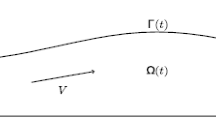Abstract
A typical linear water-wave problem is a boundary-value problem involving partial differential equations and boundary conditions. Such a problem is usually solved by applying a sequence of mathematical arguments, and it would be helpful if some or all of the successive steps in this sequence could be given a physical interpretation. In the author’s experience this is generally not possible. Illustrative examples are presented.
Similar content being viewed by others
References
Lamb H (1932) Hydrodynamics, 6th edn. Cambridge University Press
Ursell F (1986) Mathematical observations on the method of multipoles. Schiffstechnik 23:113–128
Ursell F (1960) On Kelvin’s ship-wave pattern. J Fluid Mech 8:418–431
Havelock TH (1908) The propagation of groups of waves in dispersive media. Proc R Soc London A 81:398–430
Chester C, Friedman B, Ursell F (1957) An extension of the method of steepest descents. Proc Cambridge Philos Soc 53:599–611
Ursell F (1965) Integrals with a large parameter. The continuation of uniformly asymptotic expansions. Proc Cambridge Philos Soc 61:113–128
Ursell F (1972) Integrals with a large parameter. Several nearly coincident saddle points. Proc Cambridge Philos Soc 72:49–65
Ursell F (1990) Integrals with a large parameter and the maximum-modulus principle. Asymptotic and computational analysis, In Wong R (ed) pp 477–489
Ursell F (1968) The expansion of water-wave potentials at great distances. Proc Cambridge Philos Soc 64:811–826
Ursell F (1953) Short surface waves due to an oscillating immersed body. Proc R Soc London A 220:90–103
Ursell F (1964) The decay of the free motion of a floating body. J Fluid Mech 19:305–319
Rhodes-Robinson PF (1970) On the short-wave asymptotic motion due to a cylinder heaving on water of finite depth. Proc Cambridge Philos Soc 70:423–442, Part I, 70:443–468, Part II
Maskell SJ, Ursell F (1970) The transient motion of a floating body. J Fluid Mech 44:303–313
Clarisse J-M, Newman JN, Ursell F (1995) Integrals with a large parameter: water waves on finite depth due to an impulse. Proc R Soc Lond A 450:67–87
Ursell F (1980) Integrals with a large parameter: a double complex integral with four nearly coincident saddle-points. Math Proc Cambridge Philos Soc 87:249–273
Author information
Authors and Affiliations
Corresponding author
Additional information
To Nick Newman on his seventieth birthday




